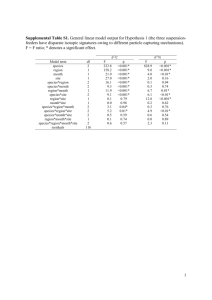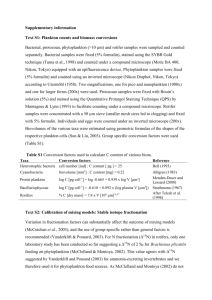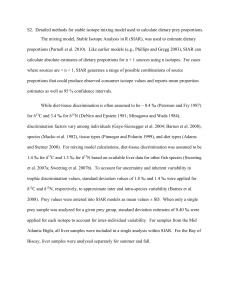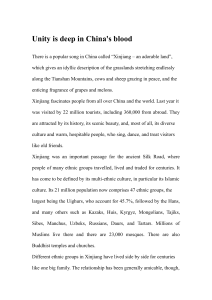Stable isotope analysis of diet among Bronze Age and Iron... Xinjiang Uyghur Autonomous Region, China
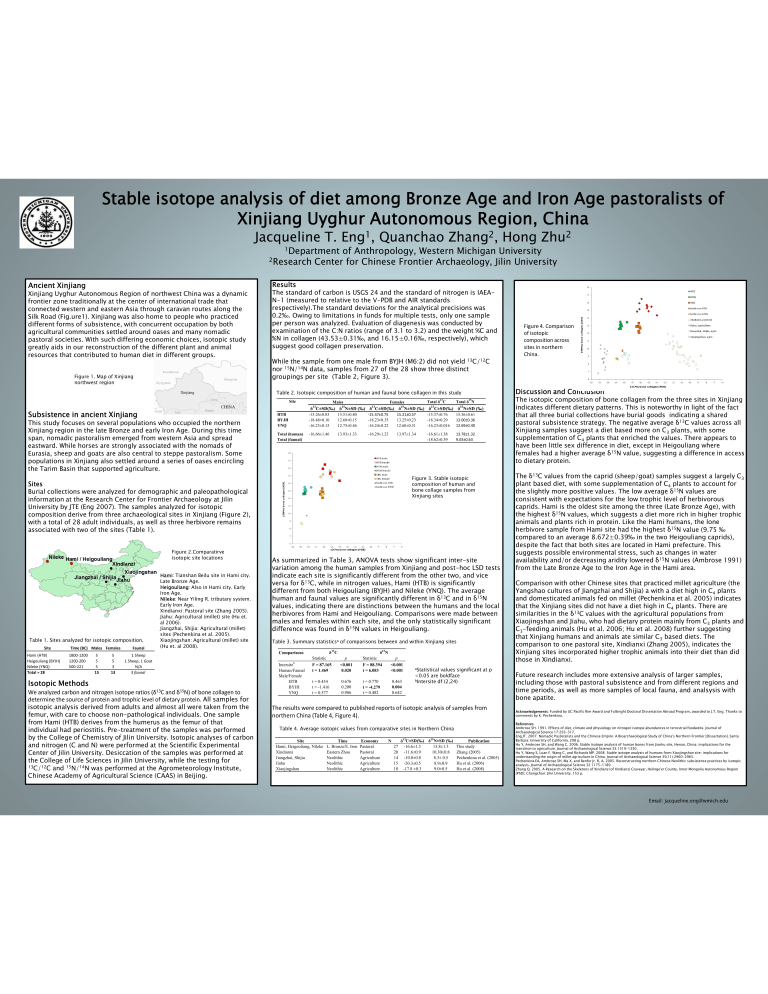
Stable isotope analysis of diet among Bronze Age and Iron Age pastoralists of
Xinjiang Uyghur Autonomous Region, China
Jacqueline T. Eng 1 , Quanchao Zhang 2 , Hong Zhu 2
1
Department of Anthropology, Western Michigan University
2
Research Center for Chinese Frontier Archaeology, Jilin University
Ancient Xinjiang
Xinjiang Uyghur Autonomous Region of northwest China was a dynamic frontier zone traditionally at the center of international trade that connected western and eastern Asia through caravan routes along the
Silk Road (Fig.ure1). Xinjiang was also home to people who practiced different forms of subsistence, with concurrent occupation by both agricultural communities settled around oases and many nomadic pastoral societies. With such differing economic choices, isotopic study greatly aids in our reconstruction of the different plant and animal resources that contributed to human diet in different groups.
Figure 1. Map of Xinjiang northwest region
Results
The standard of carbon is USGS 24 and the standard of nitrogen is IAEA-
N-1 (measured to relative to the V-PDB and AIR standards respectively).The standard deviations for the analytical precisions was
0.2‰. Owing to limitations in funds for multiple tests, only one sample per person was analyzed. Evaluation of diagenesis was conducted by examination of the C:N ratios (range of 3.1 to 3.2) and the weight %C and
%N in collagen (43.53±0.31‰, and 16.15±0.16‰, respectively), which suggest good collagen preservation.
While the sample from one male from BYJH (M6:2) did not yield 13 C/ 12 C nor 15 N/ 14 N data, samples from 27 of the 28 show three distinct groupings per site (Table 2, Figure 3).
HTB
BYJH
YNQ
Site f h d f l b ll h d
Males Females Total δ
13
C Total δ
15
N
δ 13 C±SD(‰) δ 15 N±SD (‰) δ 13 C±SD(‰) δ 15 N±SD (‰) δ 13 C±SD(‰) δ 15 N±SD (‰)
-15.26±0.83
15.51±0.80
-18.48±0.10
12.68±0.15
-16.23±0.15
12.75±0.46
-15.47±0.75
-18.23±0.35
-16.24±0.22
15.21±0.37
13.25±0.23
12.60±0.31
-15.37±0.76
15.36±0.61
-18.34±0.29
13.00±0.36
-16.23±0.016
12.69±0.40
Total (human) -16.66±1.46
13.93±1.33
Total (faunal)
-16.29±1.23
13.97±1.34
-16.61±1.38
13.78±1.32
-18.62±0.39
9.03±0.63
Figure 4. Comparison of isotopic composition across sites in northern
China.
Subsistence in ancient Xinjiang
This study focuses on several populations who occupied the northern
Xinjiang region in the late Bronze and early Iron Age. During this time span, nomadic pastoralism emerged from western Asia and spread eastward. While horses are strongly associated with the nomads of
Eurasia, sheep and goats are also central to steppe pastoralism. Some populations in Xinjiang also settled around a series of oases encircling the Tarim Basin that supported agriculture.
Sites
Burial collections were analyzed for demographic and paleopathological f h h f h l
University by JTE (Eng 2007). The samples analyzed for isotopic l composition derive from three archaeological sites in Xinjiang (Figure 2), with a total of 28 adult individuals, as well as three herbivore remains associated with two of the sites (Table 1).
Figure 2.Comparatirve isotopic site locations
Hami: Tianshan Beilu site in Hami city.
Late Bronze Age.
Heigouliang: Also in Hami city. Early
Iron Age.
Nileke: Near Yiling R. tributary system.
Early Iron Age.
Xindianxi: Pastoral site (Zhang 2005).
Jiahu: Agricultural (millet) site (Hu et. al 2006).
Jiangzhai, Shijia: Agricultural (millet) sites (Pechenkina et al. 2005).
Xiaojingshan: Agricultural (millet) site
(Hu et. al 2008).
Table 1. Sites analyzed for isotopic composition.
Site
Hami (HTB)
Heigouliang (BYJH)
Nileke (YNQ)
Total = 28
Time (BC) Males Females
1800-1200 5
1200-200
500-221
5
5
15
5
5
3
13
Faunal
1 Sheep
1 Sheep, 1 Goat
N/A
3 faunal
Isotopic Methods
We analyzed carbon and nitrogen isotope ratios ( δ 13 C and δ 15 N) of bone collagen to determine the source of protein and trophic level of dietary protein.
All samples for isotopic analysis derived from adults and almost all were taken from the femur, with care to choose non-pathological individuals. One sample from Hami (HTB) derives from the humerus as the femur of that individual had periostitis. Pre-treatment of the samples was performed by the College of Chemistry of Jilin University. Isotopic analyses of carbon and nitrogen (C and N) were performed at the Scientific Experimental
Center of Jilin University. Desiccation of the samples was performed at the College of Life Sciences in Jilin University, while the testing for
13 C/ 12 C and 15 N/ 14 N was performed at the Agrometeorology Institute,
Chinese Academy of Agricultural Science (CAAS) in Beijing.
Figure 3. Stable isotopic composition of human and bone collage samples from
Xinjiang sites
As summarized in Table 3, ANOVA tests show significant inter-site variation among the human samples from Xinjiang and post-hoc LSD tests indicate each site is significantly different from the other two, and vice versa for δ 13 C, while in nitrogen values, Hami (HTB) is significantly different from both Heigouliang (BYJH) and Nileke (YNQ). The average human and faunal values are significantly different in δ 13 C and in δ 15 N values, indicating there are distinctions between the humans and the local herbivores from Hami and Heigouliang. Comparisons were made between males and females within each site, and the only statistically significant difference was found in δ 15 N values in Heigouliang.
Table 3. Summary statistics a of comparisons between and within Xinjiang sites
Comparisons
Intersite b
Human/Faunal
Male/Female
HTB
BYJH
YNQ
δ 13 C
Statistic p
F = 87.165
<0.001
t = 1.469
0.020
t = 0.434
t = -1.416
t = 0.577
0.676
0.200
0.986
δ 15 N
Statistic p
F = 88.394
<0.001
t = 6.083
<0.001
t = 0.770
t = -4.279
t = 0.482
0.463
0.004
0.642
a Statistical values significant at p
<0.05 are boldface b Intersite df (2,24) northern China (Table 4, Figure 4).
Table 4. Average isotopic values from comparative sites in Northern China
Site Time Economy
Hami, Heigouliang, Nileke L. Bronze/E. Iron Pastoral
Xindianxi Eastern Zhou Pastoral
Jiangzhai, Shijia
Jiahu
Xiaojingshan
Neolithic
Neolithic
Neolithic
Agriculture
Agriculture
Agriculture
N
27
δ 13 C±SD(‰) δ
-16.6±1.3
15 N±SD (‰) Publication
13.8±1.3
This study
20 -11.6±0.9
10.30±0.8
Zhang (2005)
14 -10.0±0.8
15 -20.3±0.5
10 -17.8 ±0.3
8.3± 0.5
Pechenkina et al. (2005)
8.9±0.9
Hu et al. (2006)
9.0±0.5
Hu et al. (2008)
The isotopic composition of bone collagen from the three sites in Xinjiang indicates different dietary patterns. This is noteworthy in light of the fact that all three burial collections have burial goods indicating a shared pastoral subsistence strategy. The negative average δ 13 C values across all
Xinjiang samples suggest a diet based more on C
3 supplementation of C
4 have been little sex difference in diet, except in Heigouliang where females had a higher average δ 15 N value, suggesting a difference in access to dietary protein.
plants, with some plants that enriched the values. There appears to
The δ 13 C values from the caprid (sheep/goat) samples suggest a largely C
3 plant based diet, with some supplementation of C
4 plants to account for the slightly more positive values. The low average δ 15 N values are i i h i f h l hi l l f h bi caprids. Hami is the oldest site among the three (Late Bronze Age), with the highest δ 15 N values, which suggests a diet more rich in higher trophic animals and plants rich in protein. Like the Hami humans, the lone herbivore sample from Hami site had the highest δ 15 N value (9.75 ‰ compared to an average 8.672±0.39‰ in the two Heigouliang caprids), despite the fact that both sites are located in Hami prefecture. This suggests possible environmental stress, such as changes in water availability and/or decreasing aridity lowered δ 15 N values (Ambrose 1991) from the Late Bronze Age to the Iron Age in the Hami area.
Comparison with other Chinese sites that practiced millet agriculture (the
Yangshao cultures of Jiangzhai and Shijia) a with a diet high in C
4 plants and domesticated animals fed on millet (Pechenkina et al. 2005) indicates that the Xinjiang sites did not have a diet high in C
4 plants. There are similarities in the δ 13 C values with the agricultural populations from
Xiaojingshan and Jiahu, who had dietary protein mainly from C
3
C
3 that Xinjiang humans and animals ate similar C plants and
-feeding animals (Hu et al. 2006; Hu et al. 2008) further suggesting
3 based diets. The comparison to one pastoral site, Xindianxi (Zhang 2005), indicates the
Xinjiang sites incorporated higher trophic animals into their diet than did those in Xindianxi.
Future research includes more extensive analysis of larger samples, including those with pastoral subsistence and from different regions and time periods, as well as more samples of local fauna, and analsysis with bone apatite.
Acknowledgements: Funded by UC Pacific Rim Award and Fulbright Doctoral Dissertation Abroad Program, awarded to J.T. Eng. Thanks to comments by K. Pechenkina.
References
Ambrose SH. 1991. Effects of diet, climate and physiology on nitrogen isotope abundances in terrestrial foodwebs. Journal of
Archaeological Science 17:293-317.
Eng JT. 2007. Nomadic Pastoralists and the Chinese Empire: A Bioarchaeological Study of China's Northern Frontier [Dissertation]. Santa
Barbara: University of California. 298 p.
Hu Y, Ambrose SH, and Wang C. 2006. Stable isotope analysis of human bones from Jianhu site, Henan, China: implications for the transition to agriculture. Journal of Archaeological Science 33:1319-1330.
Hu Y, Wang S, Luan F, Wang C, and Richards MP. 2008. Stable isotope analysis of humans from Xiaojingshan site: implications for understanding the origin of millet agriculture in China. Journal of Archaeological Science 35(11):2960-2965.
Pechenkina EA, Ambrose SH, Ma X, and Benfer Jr. R, A. 2005. Reconstructing northern Chinese Neolithic subsistence practices by isotopic analysis. Journal of Archaeological Science 32:1175-1189.
Zhang Q. 2005. A Research on the Skeletons of Xindianzi of Xindianzi Graveyar, Helinge'er County, Inner Mongolia Autonomous Region
[PhD]. Changchun: Jilin University. 153 p.
Email: jacqueline.eng@wmich.edu
